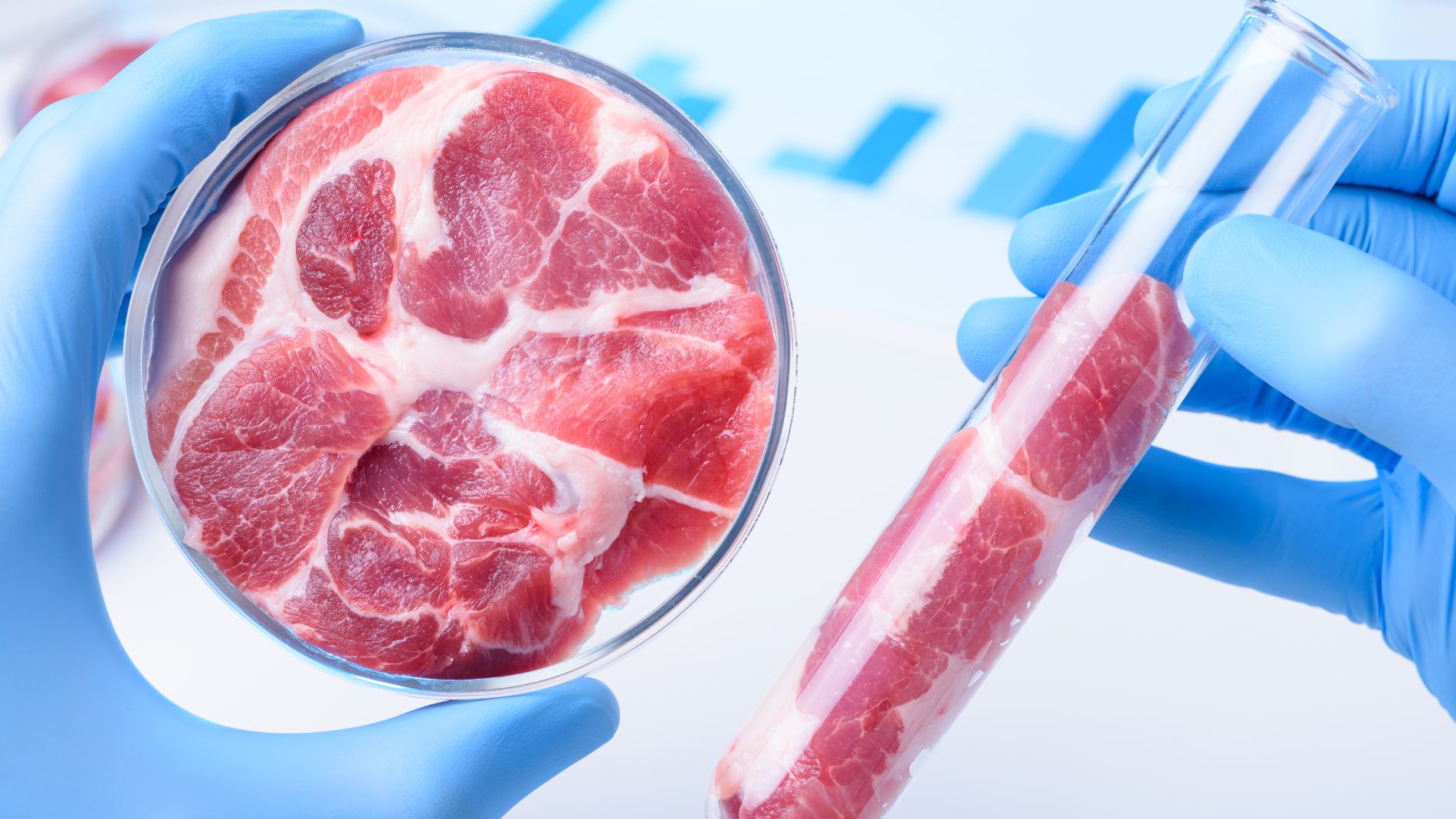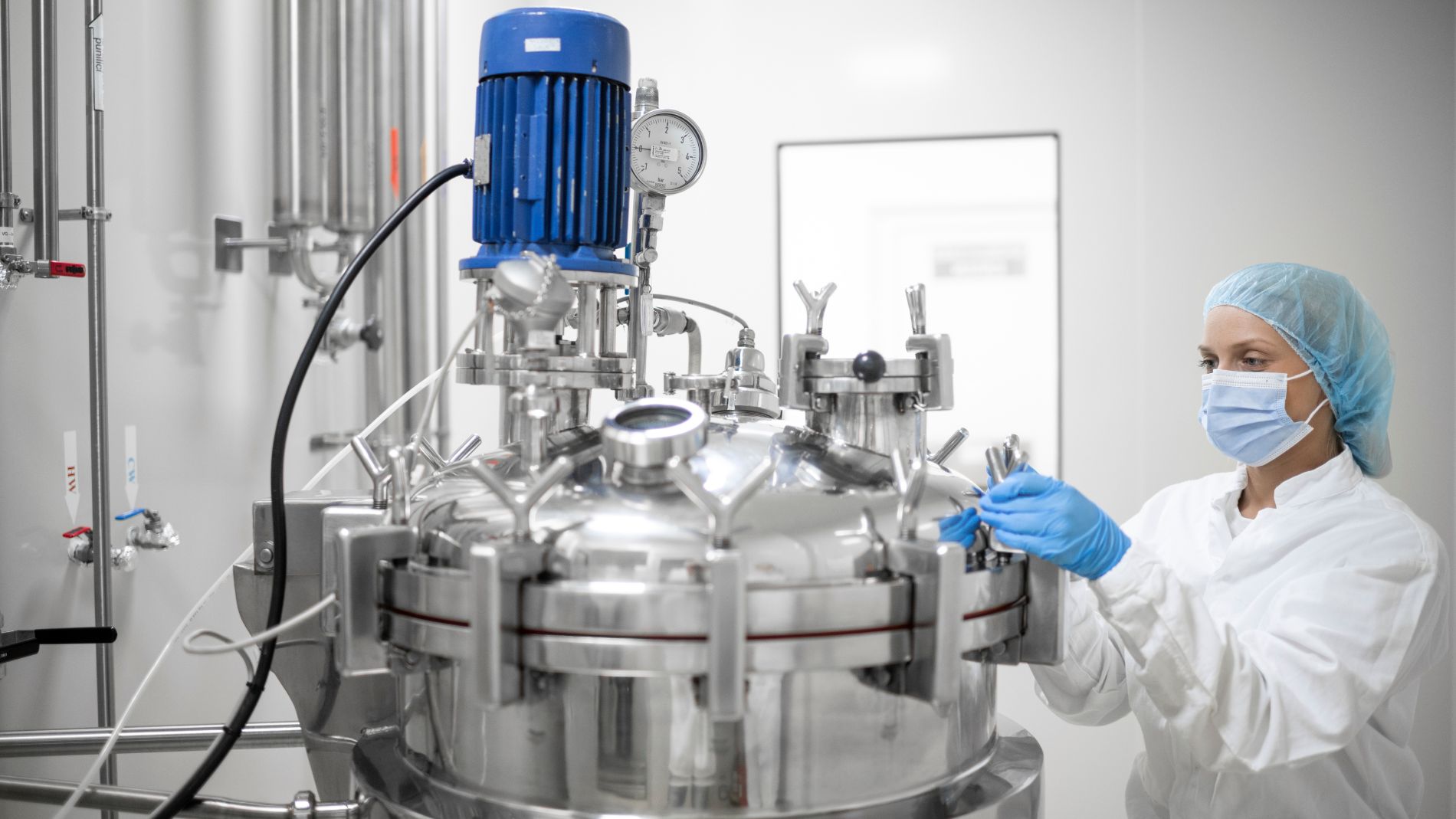The process of manufacturing cell cultures is revolutionising food production. It offers sustainable, animal-free alternatives to conventional proteins and promotes innovative nutrition solutions.
Production of cultured meat or cultured fish

Biotechnologies are used to grow animal cells outside of an animal's body. This cultivation process produces muscle and fat cells in a controlled environment.
- Cell collection: First, stem cells are taken from animals.
- Cell cultivation: The collected cells are cultivated in a bioreactor with a nutrient medium to promote cell growth. These cells proliferate and form muscle and fat cells.
- Tissue development: To achieve a structure similar to meat, the cells are placed on special carrier substrates or grown in bioreactors where they can organise themselves into tissues.
- Maturation: The cultured tissues must mature to develop the right texture and taste. This can be done by mechanical stimulation or other methods.
Research in the field of cultured meat has made significant progress in recent years. Many companies and research institutes are working on optimising cell culture techniques and improving culture media and maturation methods.
To scale up production to an industrial level, production costs need to be further reduced and efficiency increased through technological innovation.
Market approval of cell products
In the United States, the FDA (Food and Drug Administration) has developed guidelines for the safety and regulation of cellular meat together with the USDA (United States Department of Agriculture). The first licences for cellular meat have been issued in the United States and Israel, but no products are yet on the market. Singapore was the first country in the world to approve a hybrid product based on cellular chicken meat.
In the EU, the EFSA (European Food Safety Authority) has received several applications for the authorisation of cultured meat. In addition to data on product safety, an application must include information on the cells used, the manufacturing process and the nutrient profile of the product. The EFSA checks whether the product is safe for human consumption. It is not known when the first cell-based meat products will be approved in the EU and how the regulatory framework will develop (as of January 2025).
Acceptance of cell products and challenges
The following arguments are put forward in favour of cell meat as an alternative to conventional meat production: less animal suffering than in factory farming, no use of antibiotics, sterility, lower land use and lower water requirements.
The frequently cited argument of lower CO2 emissions is vague, as the actual energy required for the industrial-scale production of cell meat and the exact structure of production plants are unknown.
For companies that want to produce and sell cultured meat, the issues of technical challenges and production costs for mass marketing, product approval and product labelling are currently on the agenda. In addition, cell meat producers have to prove their stability and do a lot of persuading. In Europe, but also in the USA, there are initial bans and initiatives to legally prohibit cell meat.
Targeted marketing strategies that focus on sustainability, ethical or health aspects can help to convince consumers.1
Fermentation as a key process

Fermentation plays an important role not only in the production of many traditional foods, but also in the production of innovative foods such as protein alternatives. Microorganisms such as bacteria, yeasts or fungi, as well as their natural processes, are used to produce proteins or enzymes from various substrates.
Biomass and precision fermentation are innovative processes that can be used to produce sustainable protein alternatives and thus reduce the demand for animal products.
While biomass fermentation is based on microbial growth to produce protein-rich biomass, precision fermentation uses genetically modified organisms to produce specific proteins or enzymes.
Biomass Fermentation

Biomass fermentation uses microorganisms such as bacteria, yeast or fungi to convert organic materials (e.g. sugar or other carbohydrates) into biomass. These microbes grow and multiply in a suitable nutrient medium.
Depending on the nutrient medium, the microbes ferment with or without oxygen, under anaerobic or aerobic conditions.
During the fermentation process, they produce biomass that is rich in proteins. After fermentation, this biomass can be harvested and further processed. These products can be used as meat alternatives or as high-protein ingredients in food.
The production of sauerkraut (lactic acid fermentation) or Quorn (mushroom fermentation) are examples of biomass fermentation.
Precision fermentation

Precision fermentation involves introducing or modifying specific genes in microorganisms such as bacteria, fungi or yeasts to produce certain proteins or enzymes. This often involves the use of genetically modified material to design and adapt microorganisms to produce specific products efficiently and sustainably.
As in biomass fermentation, the microbial cells ferment the nutrient medium and produce the desired protein or enzyme. This may be an animal protein suitable for human consumption, for example.
After fermentation, the product is harvested and purified to separate the target protein from the cells and other components of the medium.
One example of precision fermentation is the production of animal proteins such as milk proteins (casein) by genetically modified yeasts or bacteria. These products can then be used in plant-based dairy alternatives such as dairy-free cheese.
Quellen:
1 Cell-Cultured Meat Updates: state bans, labeling requirements, and regulatory clarifications - National Agricultural Law Center 27.01.2025.; More states lining up to ban cell-grown meat https://www.foodsafetynews.com/2024/09/more-states-lining-up-to-ban-cell-grown-meat/ 27.01.2025.